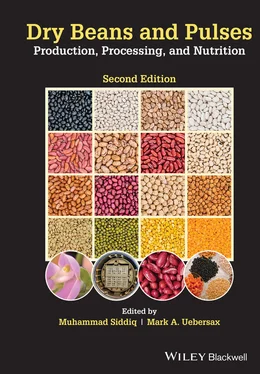Dry Beans and Pulses Production, Processing, and Nutrition
Здесь есть возможность читать онлайн «Dry Beans and Pulses Production, Processing, and Nutrition» — ознакомительный отрывок электронной книги совершенно бесплатно, а после прочтения отрывка купить полную версию. В некоторых случаях можно слушать аудио, скачать через торрент в формате fb2 и присутствует краткое содержание. Жанр: unrecognised, на английском языке. Описание произведения, (предисловие) а так же отзывы посетителей доступны на портале библиотеки ЛибКат.
- Название:Dry Beans and Pulses Production, Processing, and Nutrition
- Автор:
- Жанр:
- Год:неизвестен
- ISBN:нет данных
- Рейтинг книги:5 / 5. Голосов: 1
-
Избранное:Добавить в избранное
- Отзывы:
-
Ваша оценка:
- 100
- 1
- 2
- 3
- 4
- 5
Dry Beans and Pulses Production, Processing, and Nutrition: краткое содержание, описание и аннотация
Предлагаем к чтению аннотацию, описание, краткое содержание или предисловие (зависит от того, что написал сам автор книги «Dry Beans and Pulses Production, Processing, and Nutrition»). Если вы не нашли необходимую информацию о книге — напишите в комментариях, мы постараемся отыскать её.
The second edition of the most complete and authoritative reference on dry beans production, processing, and nutrition available Dry Beans and Pulses: Production, Processing, and Nutrition
Dry Beans and Pulses: Production, Processing, and Nutrition, Second Edition
Dry Beans and Pulses Production, Processing, and Nutrition — читать онлайн ознакомительный отрывок
Ниже представлен текст книги, разбитый по страницам. Система сохранения места последней прочитанной страницы, позволяет с удобством читать онлайн бесплатно книгу «Dry Beans and Pulses Production, Processing, and Nutrition», без необходимости каждый раз заново искать на чём Вы остановились. Поставьте закладку, и сможете в любой момент перейти на страницу, на которой закончили чтение.
Интервал:
Закладка:
Further, seed moisture content, storage temperature, and duration of storage each directly influence bean quality and are thus important factors to consider during dry bean storage (Nasar‐Abbas et al. 2009; Rani et al. 2013).
Moisture content
The aggregate moisture content of bean seed is the most important consideration during harvest and storage. Seeds with moisture content above 18% are subjected to excessive damage during storage and in the processing line, due to physical susceptibility to mechanical forces and microbial spoilage from molds. However, seeds with moisture content below 15% are increasingly sensitive to impact damage. Dry beans have been studied widely with respect to storage stability and quality (McCurdy et al. 1980; Uebersax and Bedford 1980; Dhahir 1987; Rani et al. 2013). Respiration rates of beans decrease with moisture concentrations as beans mature (Swanson et al. 1977), with none detected at beans of <18% moisture.
Beans stored at too low moisture exhibit increased clumping and splitting upon canning due to seed coat and cotyledon rupture, while storage at high initial moisture encourages discoloration, off‐flavor development, loss of water uptake capacity, and mold growth. Morris and Wood (1956) reported that beans with moisture content above 13% deteriorated significantly in both flavor and texture after six months at 77 °F and became unpalatable within 12 months. Burr et al. (1968) reported that beans stored at high moisture showed a significant increase in their required cooking time while low moisture did not lose their cooking quality.
McCurdy et al. (1980) evaluated and compared different moisture equilibration and moisture determination methods with dry beans and indicated significant variation among individual dry beans for all methods of moisture equilibration, especially with direct addition of water, but observed no significant differences among the methods of moisture analysis. Storage A moisture content of 14.1% (a w= 0.755) or less was recommended when storing pinto beans for microbial stability. It was recommended that a mean and coefficient of variation for moisture content of a representative sample should be used to define the actual condition of the beans.
Storage temperature and time
As is consistent with all biological systems, bean quality degradation occurs faster at relatively higher temperatures (Burr et al. 1968; Bradford et al. 2018). Uebersax and Bedford (1980) reported that navy bean quality deteriorates during storage with increases in relative humidity (RH) and temperature, both for dry and subsequently processed beans. Stable quality was obtained in navy beans stored at 75% RH or less with temperatures of 20°C (70°F) or lower. Mold growth occurred on beans stored at 20°C (70°F) and 30°C (85°F) when the relative humidity was greater than 75% (16% moisture). Deterioration rates based on seed discoloration and mold growth was minimized in beans stored at 55°F under relative humidity ranging from 75% to 86%. The influence of increased storage temperature became greater at higher relative humidity.
Chemical and biological changes occur during dry bean storage. Dhahir (1987) reported increased total protein and pectin solubility for cold water, but decreased soluble protein, soluble solids, and pectin solubility in hot water and alkaline solution for dry beans (navy, black, pinto, and kidney) stored for 9 months at 18% moisture at 5°C, 20°C, and 35°C. Additionally, three bean cultivars of navy (Seafarer), pinto (Oletha), and kidney (Montcalm) were stored at three different storage temperatures (5°C, 20°C, and 35°C) with moisture levels of 10–18%. As storage temperature and moisture content increased, both the cooking time and processed bean firmness (shear force) increased. Results demonstrated a high correlation between cooking time and shear force.
Beans are typically stored with good cooking and processing quality up to one year; however, they are commonly held as carryover beyond one season. Storage beyond one year presents higher risks of quality deterioration due to physiological changes that can result in adverse storage‐induced defects, e.g., hard‐to‐cook phenomena and seed discoloration (Uebersax and Siddiq 2012).
Off‐flavor development during transit/storage
Off‐flavors in pulses are partially inherent and partially produced during harvesting, transit, and storage (Roland et al. 2017; Liburdi et al. 2021). Pulses are susceptible to off‐flavor development from cross‐contamination of various phenolics and other compounds, as summarized in Table 4.1 . Shipping containers or vessels can impart taints to dry beans if they were previously used for machinery and petroleum‐based products (oils, grease, etc.). It is common practice to use segregated food grade or “bean only” containers, e.g., in overseas shipments of beans for canning. The off‐flavors developed can be assessed by volatiles analysis (raw and prepared beans) and organoleptic evaluation (prepared beans) by sensory panellists. Bassett et al. (2021) suggested including flavor and texture attributes in breeding programs for the development of new varieties that entice growers, consumers, and product developers.
Postharvest losses
Beans are subject to losses during preharvest and postharvest stages. Globally, postharvest quality losses of dry beans are extensive and dramatically impact acceptability of use particularly by increasing the time and energy requirements for preparation and decreases in palatability and nutrient bioavailability (Jones 1999). In the United States, crop losses from birds and mammals during crop growth are limited (around 1%) (May 1977). However, postharvest losses are substantial, with overall losses of stored food due to insects, rodents and microorganisms estimated at approximately 9% (Uebersax and Siddiq 2012).
A general estimate of postharvest losses ranges from 9% in the United States to 40–50% in some developing nations (Pimentel 1976). It has been indicated that pest populations consume or destroy nearly one‐third to one‐half of the world food supply. The quantitative losses of world grain legumes during storage demonstrate wide ranges (up to > 60% in selected cases), primarily attributed to insects (e.g., bruchids), rodents, microbiological spoilage (primarily molds) and physiological deterioration/breakdown (Anon. 1978). It is clearly recognized that harmful microorganisms, insects, and extraneous contamination agents can cause health hazards in food (Testin and Vergano 1990). The use of appropriate packaging is essential for reducing postharvest losses and serves the vital role in storage, distribution, and marketing.
Table 4.1. Compounds associated with off‐flavor in dry beans/ pulses during transit and storage.
| Compound | Origin/source | Cross‐contamination and effect |
|---|---|---|
| 2,4,6‐Trichloroanisole (TCA) | A fungicide, present in minute amounts in paper packaging. | Shipping containers and vessels; flavors/odors (described as medicinal or as a phenolic taint) in wines, coffee, and beans. |
| 2‐methylisoborneol (MIB) and Geosmin | Microbial metabolites produced under anaerobic conditions, e.g., by Actinomyces bacteria. | Shipping containers and vessels; minute amounts (~1 ppb geosmin and ~15 ppm MIB) can cause earthy or musty off‐flavor in dry beans. |
| Chlorophenols | Produced during chlorine bleaching to sterilize/bleach wood/paper products from reaction of hypochlorite with lignin. | Shipping pallets; Rio off‐flavor in coffee, mild off‐flavor in dry beans. |
Source: Buttery et al. (1976); Swanson and Hernandez (1984); Chambers IV et al. (1998); Iamanaka et al. (2014); Slabizki et al. (2016).
Читать дальшеИнтервал:
Закладка:
Похожие книги на «Dry Beans and Pulses Production, Processing, and Nutrition»
Представляем Вашему вниманию похожие книги на «Dry Beans and Pulses Production, Processing, and Nutrition» списком для выбора. Мы отобрали схожую по названию и смыслу литературу в надежде предоставить читателям больше вариантов отыскать новые, интересные, ещё непрочитанные произведения.
Обсуждение, отзывы о книге «Dry Beans and Pulses Production, Processing, and Nutrition» и просто собственные мнения читателей. Оставьте ваши комментарии, напишите, что Вы думаете о произведении, его смысле или главных героях. Укажите что конкретно понравилось, а что нет, и почему Вы так считаете.












